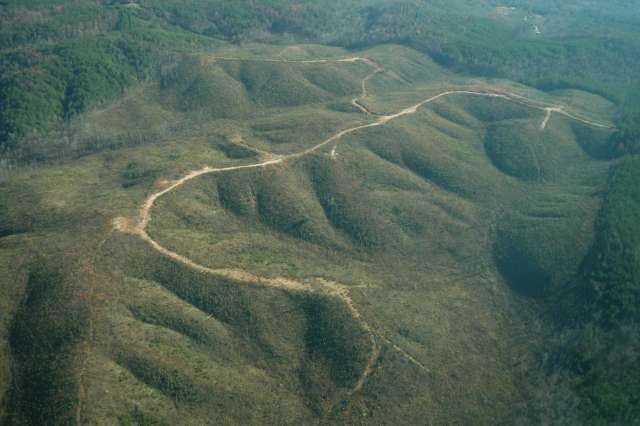Once home to majestic stands of deciduous Appalachian forests, longleaf pine stands, and river bottomland hardwood forests, Alabama now has very little of its virgin timber left. Forestry practices have culled out what was an amazing living system. Old growth trees and their extensive root systems created ideal habitat for native plants and animals, and served as a filter for rainwater and pollutants. Runoff patterns were much different then since all of the vegetation used large amounts of water. When it rained water did not rush off the land, scouring everything in its path. Eroded fields and hillsides and crumbling stream banks are a result of our forestry practices over the past several hundred years. Our forest systems were the web that held everything together.
Forestry practices are often the first assault on our forests. Before mining, road building, and development can take place, the trees must be cleared. In the olden days, man logged timber with saws and chainsaws and used horses to move trees to carts and rail. Machines can now do in a day what would take men weeks. Many foresters today operate in a haphazard and rushed manner. The result is denuded landscapes and the loss of historical artifacts, native plant habitat, and the erosion of water quality.
Unfortunately Alabama does not have a strong set of laws and regulations governing forestry practices. When it comes time to cut trees, land owners and foresters are allowed to police themselves. Best management practices are a set of voluntary erosion and sediment control measures that the Alabama Forestry Commission http://www.forestry.state.al.us can only persuade landowners to follow. If you ever see a logging operation that is allowing mud into a stream or lake, contact the Forestry Commission and make a complaint. When it comes to streamside buffers, or areas where the vegetation cannot be removed, loggers typically only have to leave around thirty feet on either side of a stream, depending on the slope. This is not enough of a buffer to protect water quality or the integrity of a stream. We all know that streams are dynamic systems that are constantly moving, so they need to have flexibility. On smaller drainages that only have running water for part of the year, there or little to no protections. Streams can be crossed. Wetlands in Alabama can be temporarily drained and logging roads can be built so long as these activities do not cause a conversion of the wetland to an upland.
Many foresters like to say that we have more forest in Alabama now than we have had in the past hundred years. A loblolly pine plantation is not a forest, it is a monocrop. These eyesores are a result of the hapless clearcutting of our diverse native forests. In losing these inspiring Appalachian forests, we are losing native plants and wildlife. Loblolly pines are being planted by the forest because they grow rapidly and return a quick monetary yield. A part of the process for large industrial operations is the widescale use of pesticides and herbicides. These chemical products have been linked to reptilian decline, and are certainly no blessing when it comes to water quality.
 Clearcutting in the North River Basin (Tuscaloosa County).
Clearcutting in the North River Basin (Tuscaloosa County).
Photo by Nelson Brooke. Flight provided by Southwings.org












